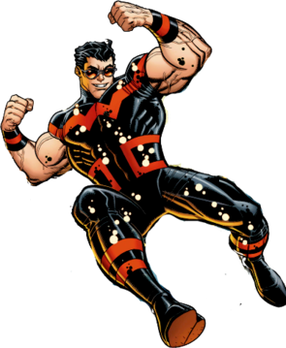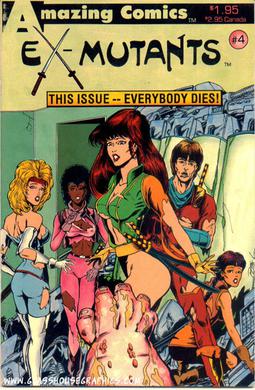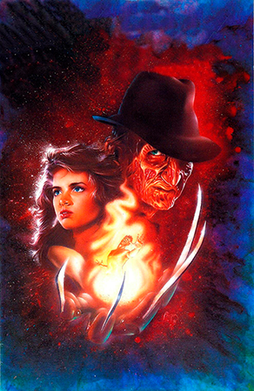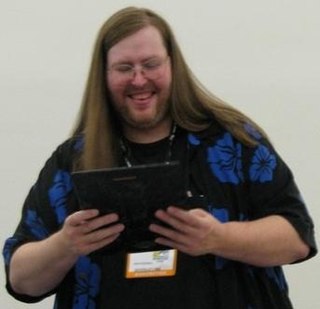
The Young All-Stars are a team of fictional DC Comics superheroes. They were created by Roy Thomas, Dann Thomas, and Michael Bair, and introduced in Young All-Stars #1, dated June 1987. The team members Tsunami, Neptune Perkins, and Dan the Dyna-Mite were all introduced in previously published DC Comics stories. The team members Iron Munro, Flying Fox, and Fury were created for the series and intended to be analogs of the Golden Age versions of Superman, Batman, and Wonder Woman respectively.

William Francis Messner-Loebs is an American comics artist and writer from Michigan, also known as Bill Loebs and Bill Messner-Loebs. His hyphenated surname is a combination of his and his wife Nadine's unmarried surnames.

Wonder Man is a fictional character appearing in American comic books published by Marvel Comics. Created by writer Stan Lee and artists Don Heck and Jack Kirby, he first appeared in The Avengers #9. The character, who was initially introduced as a supervillain imbued with "ionic" energy, fought the Avengers and after a series of events, he was reborn as a superhero joining the team against which he originally fought.

Manhunter is the name given to several different fictional characters appearing in comic books published by DC Comics. They are depicted as superheroes and antiheroes.

Pied Piper is a supervillain turned superhero appearing in comic books published by DC Comics, and is commonly associated with the superhero the Flash. The character was created by writer John Broome and artist Carmine Infantino, and made his first appearance in The Flash #106.
Greg LaRocque is an American comics artist best known for his work on the Legion of Super-Heroes and The Flash.
The Justice Machine is a fictional team of superheroes originally created by Mike Gustovich and appearing in comic books from many small publishers in the 1980s and 1990s. In addition to Gustovich, writers Tony Isabella and Mark Ellis have also had lengthy creative associations with Justice Machine.
Pied Piper Comics was a short-lived American comic book publishing company that operated from 1986 to 1988. The company was founded by Mark L. Hamlin and Roger McKenzie, with writer/editor David Campiti playing a major role.

Sentry is a superhero appearing in American comic books published by Marvel Comics. Created by Paul Jenkins and Jae Lee, with uncredited conceptual contributions by Rick Veitch, the character first appeared in The Sentry #1.

Ex-Mutants was a comic book series created by writer David Lawrence and artist Ron Lim, along with comics packager David Campiti in 1986. It was first published by Eternity Comics and then Amazing Comics, Pied Piper Comics, and finally Malibu/Eternity. Malibu created a shared universe called Shattered Earth with the characters. In 1992, Malibu comics rebooted the franchise with a new continuity. A video game for the Sega Genesis based on the rebooted version was released in 1992, being developed by Malibu Interactive and published by Sega of America, Inc.
The Holyoke Publishing Company was an American magazine and comic-book publisher with offices in Holyoke, and Springfield, Massachusetts, and New York City, Its best-known comics characters were Blue Beetle and the superhero duo Cat-Man and Kitten, all inherited from defunct former clients of Holyoke's printing business.
Roger McKenzie is an American comic book writer best known for his work on Daredevil with Frank Miller. McKenzie has also written for a variety of independent comics publishers, such as Pacific Comics, Comico Comics, Sirius Comics, Pied Piper Comics, and Eclipse Comics.
Innovation Publishing was an American comic book company based in Wheeling, West Virginia. It was co-founded by David Campiti in 1988 after writing a business proposal and raising US$400,000 to finance its launch. Innovation became number four in market share, below Marvel Comics, DC Comics, and Dark Horse Comics.

David Campiti is an American animation producer, comic book writer, talent agent, and packager. He was deeply involved with a number of comics publishers in the late 1980s and early 1990s, including Eternity Comics, Pied Piper Comics, and his own entity, Innovation Publishing. As CEO of Glass House Graphics, Campiti oversees an international animation studio and agency of illustrators, writers, painters, and digital designers.
Sunrise Distribution a.k.a. Sunrise Comics and Games was a Commerce, California-based comic book distributor which operated in the early-to-mid 1980s. Owned by Scott Mitchell Rosenberg, the company was intimately connected to a number of small comic book publishers from that era, including Eternity Comics and Malibu Comics, as well as three extremely short-lived publishers: Amazing, Imperial Comics, and Wonder Color.

Nightmares on Elm Street is a six-issue comic book limited series set within the A Nightmare on Elm Street franchise, set chronologically between A Nightmare on Elm Street 5: The Dream Child (1989) and Freddy's Dead: The Final Nightmare (1991). It was written by comic book writer Andy Mangels and published bimonthly throughout 1991 and 1992 by Innovation Publishing. The first two issues revolves mainly around Nancy Thompson's fate following her murder by Freddy Krueger in A Nightmare on Elm Street 3: Dream Warriors, while issue three through six deals primarily with the return of Alice Johnson and her son Jacob to Springwood. The comics are considered to be canonical to the franchise.

Joseph Michael Linsner is an American comic book writer/artist, known as the creator of the mature-audiences supernatural character Dawn, and for his illustrations of female characters. He is a popular cover artist in the comics industry.
Sirius Comics, also known as New Sirius Productions and Prelude Graphics, was a small comic book publisher based in Queens, New York, that operated from 1985 to 1986. Owned and operated by brothers Juan Collado (Editor-in-Chief), Leopaldo Collado (President), and Jose Collado, the company specialized in fantasy comics and science fiction comics.
Comics packaging is a publishing activity in which a publishing company outsources the myriad tasks involved in putting together a comic book — writing, illustrating, editing, and even printing — to an outside service called a packager. Once the comics packager has produced the comic, they then sell it to the final publishing company.










